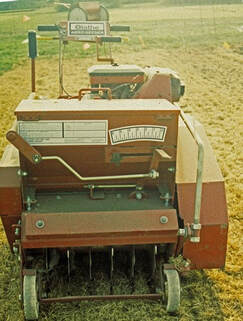 The keys to successful lawn seeding are proper rates, even dispersal, good seed to soil contact, and proper watering. Evenness is best achieved by carefully calibrating the seeder or by adjusting the seeder to a low setting and making several passes to ensure even distribution. Seeding a little on the heavy side with close overlapping is better than missing areas altogether, especially for the bunch-type tall fescue, which does not spread. Multiple seeder passes in opposite directions should help avoid this problem. A more serious error in seeding is using the improper rate. For tall fescue, aim for 6 to 8 pounds of seed per 1,000 square feet for new areas and about half as much for overseeding or seeding areas in the shade. Kentucky bluegrass has a much smaller seed so less is needed for establishment. Use 2 to 3 pounds of seed per 1,000 square feet for a new lawn and half that for overseeding or shady areas. Using too much seed results in a lawn more prone to disease and damage from stress. The best way to avoid such a mistake is to determine the square footage of the yard first, and then calculate the amount of seed. Using too little seed can also be detrimental and result in clumpy turf that is not as visually pleasing. Establishing good seed to soil contact is essential for good germination rates. Slit seeders achieve good contact at the time of seeding by dropping seed directly behind the blade that slices a furrow into the soil. Packing wheels then follow to close the furrow. The same result can be accomplished by using a verticut before broadcasting the seed, and then verticutting in a different direction a second time. Core aerators can also be used to seed grass. Go over an area at least three times in different directions, and then broadcast the seed. Germination will occur in the aeration holes. Because those holes stay moister than a traditional seedbed, this method requires less watering. If the soil that has been worked by a rototiller, firm the soil with a roller or lawn tractor and use light hand raking to mix the seed into the soil. A leaf rake often works better than a garden rake because it mixes seed more shallowly. Water newly planted areas lightly, but often. Keep soil constantly moist but not waterlogged. During hot days, a new lawn may need to be watered three times a day. If watered less, germination will be slowed. Cool, calm days may require watering only every couple of days. As the grass plants come up, gradually decrease watering to once a week if there is no rain. Let the plants tell you when to water. If you can push the blades down and they don't spring back up quickly, the lawn needs water. Once seed sprouts, try to minimize traffic (foot, mower, dog, etc.) seeded areas receive until the seedlings are a little more robust and ready to be mowed. Begin mowing once seedlings reach 3 to 4 inches tall. (Ward Upham) 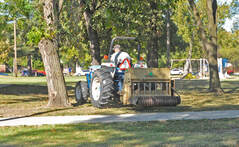 Tall fescue lawns that have become thin over the summer can be thickened up by overseeding during September. Start by mowing the grass short (1 to 1.5 inches) and removing the clippings. This will make it easier to achieve good seed-soil contact and increase the amount of light that will reach the young seedlings. Good seed-soil contact is vital if the overseeding is to be successful. Excess thatch can prevent seed from reaching the soil and germinating. Normally we want 1/4 inch of thatch or less when overseeding. If the thatch layer is 3/4 inch or more, it is usually easiest to use a sod cutter to remove it and start over with a new lawn. A power rake can be used to reduce a thatch layer that is less than 3/4 inch but more than a quarter inch. Once thatch is under control, the soil should be prepared for the seed. This can be done in various ways. For small spots, a hand rake can be used to roughen up the soil before the seed is applied. A verticut machine has solid vertical blades that can be set to cut furrows in the soil. It is best to go two different directions with the machine. A slit seeder is a verticut machine with a seed hopper added so the soil prep and seeding operation are combined. Another option is to use a core aerator. The core aerator will punch holes in the soil and deposit the soil cores on the surface of the ground. Each hole produces an excellent environment for seed germination and growth. Make three to four passes with the core aerator to ensure enough holes for the seed. Using a core aerator has the additional benefit of reducing the amount of watering needed to get the seed germinated and growing. Aeration also increases the water infiltration rate, decreases compaction, and increases the amount of oxygen in the soil. Of the three methods, I prefer the slit seeder for obtaining good seed/soil contact. However, if watering is difficult, core aeration may be a better option. Regardless of method used, fertilizer should be applied at the rate suggested by a soil test, or a starter fertilizer should be used at the rate suggested on the bag. (Ward Upham) 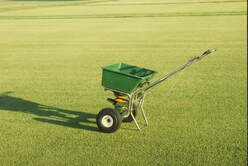 September is almost here and that means it is prime time to fertilize your tall fescue or Kentucky bluegrass lawns. If you could only fertilize your cool-season grasses once per year, this would be the best time to do it. These grasses are entering their fall growth cycle as days shorten and temperatures moderate (especially at night). Cool-season grasses naturally thicken up in the fall by tillering (forming new shoots at the base of existing plants) and, for bluegrass, spreading by underground stems called rhizomes. Consequently, September is the most important time to fertilize these grasses. Apply 1 to 1.5 pounds of actual nitrogen per 1,000 square feet. The settings recommended on lawn fertilizer bags usually result in about 1 pound of nitrogen per 1,000 square feet. We recommend a quick-release source of nitrogen at this time. Most fertilizers sold in garden centers and department stores contain either quick-release nitrogen or a mixture of quick- and slow-release. Usually only lawn fertilizers recommended for summer use contain slow-release nitrogen. Any of the others should be quick-release. The second most important fertilization of cool-season grasses also occurs during the fall. A November fertilizer application will help the grass green up earlier next spring and provide the nutrients needed until summer. It also should be quick-release applied at the rate of 1-pound actual nitrogen per 1,000 square feet. (Ward Upham) 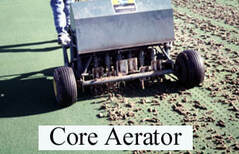 September is the optimum time to power rake or core-aerate tall fescue and Kentucky bluegrass lawns. These grasses should be coming out of their summer doldrums and beginning to grow more vigorously. This is a good time to consider what we are trying to accomplish with these practices. Power raking is primarily a thatch control operation. It can be excessively damaging to the turf if not done carefully. For lawns with one-half inch of thatch or less, I don’t recommend power raking but rather core aeration. For those who are unsure what thatch is, it is a springy layer of light-brown organic matter that resembles peat moss and is located above the soil but below the grass foliage. Power raking pulls up an incredible amount of material that then must be dealt with by composting or discarding. Core-aeration is a much better practice for most lawns. By removing cores of soil, core-aeration relieves compaction, hastens thatch decomposition, and improves water, nutrient, and oxygen movement into the soil profile. This operation should be performed when the soil is just moist enough so that it crumbles easily when worked between the fingers. Enough passes should be made so that the holes are spaced about 2 to 3 inches apart. Ideally, the holes should penetrate 2.5 to 3 inches deep. The cores can be left on the lawn to fall apart naturally (a process that usually takes two or three weeks, depending on soil-type), or they can be broken up with a power rake set just low enough to nick the cores, and then dragged with a section of chain-link fence or a steel doormat. The intermingling of soil and thatch is beneficial to the lawn. (Ward Upham) 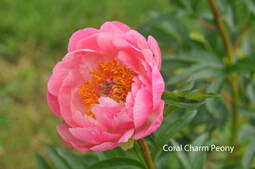 Though dividing peonies is not required, it can increase bloom production, reduce diseases and provide more peony plants free! If you choose to divide your peonies, it needs to be done this time of year. Begin by cutting the stems just above the soil surface. Dig up the entire root system and remove the soil from the roots. Divide the root clump into small sections using a sharp knife. Ensure each section has three to five buds as well as healthy roots. It may take a couple of years for the divided peony plants to return to full bloom productivity. If there are fewer buds on each division it may take three years for the plant to bloom at all. Choose a planting location that receives sunlight for at least half of the day. Dig a hole large enough to fit the roots of the divided peonies so the buds will be covered by one to two-inches of soil. Plants buried too deep may not flower. Backfill and water thoroughly. Space dwarf peonies at least two-feet apart and standard peonies four-feet apart. The winters in Kansas have periods of freezing and thawing which can be destructive to plants. Soil that freezes and thaws repeatedly can uproot plants that are not deeply rooted. This is called “heaving.” To protect the newly divided peonies, add a layer of straw, leaves or compost after the soil freezes. (Cynthia Domenghini) 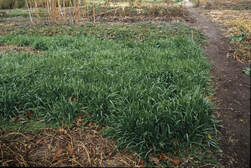 Put in the work now for a productive garden next year. Before removing plants, make a sketch of the vegetable layout. This will come in handy when you’re planning the layout for the next garden if you choose to rotate your crops. Remove debris from plants that are done producing. Compost debris that is disease-free. For smaller gardens, manually remove weeds. Larger gardens may require tilling. If so, avoid tilling while the soil is saturated as this breaks down the structure. A cover crop can be planted to return nutrients to the soil during this off season. Cover crops also reduce soil erosion and improve the quality of the soil. Small grains such as wheat should be seeded at 3/4 to 1 pound of seed per 1,000 square feet from mid-September to late October. Spring oats can also be seeded until mid-September but the rate should be 2 to 4 pounds per 1,000 square feet. Spring oats will die back in the winter and can be tilled under in the spring. Daikon radishes are another good cover crop because the large taproot penetrates the hardpan. After the radishes die back in the winter, the loosened soil is better able to retain water. Hairy vetch, alfalfa and sweetclover are legumes which means they also fix nitrogen. Seed these cover crops at a rate of ¼ to ½ pound of seed per 1,000 square feet of garden. Hairy vetch and alfalfa can be seeded from mid-August to late September while sweetclover should be seeded only until early-September. (Cynthia Domenghini) 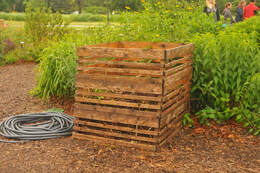
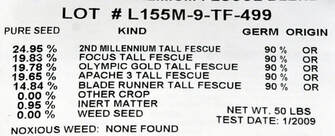 Not all grass seed is created equal. Lower quality seed can introduce unwanted weeds and a lot of extra work to eradicate it later. Orchardgrass and/or rough bluegrass (Poa trivalis) are the names to watch for when preparing to overseed. These perennial grassy weeds cannot be selectively controlled once introduced to a lawn. Orchardgrass grows more rapidly and is lighter green than our turfgrasses. It doesn’t spread but creates unsightly tufts of light green bunch grass in the lawn. Rough bluegrass creates fine-textured, circles in the lawn. Initially it can blend in with the other grasses, but turns brown quickly with the summer heat. When temperatures cool it greens up again. Understanding the contents printed on the label of the grass seed bag will save you from introducing unwanted species. Look for the percent “Other Crop Seed” or “Other Crop” printed on the label. “Other Crop” includes any species grown intentionally such as turfgrasses and pasture grasses. Unfortunately, orchardgrass and rough bluegrass fall into this category. By law, seed labels must identify the percentage, by weight, of “Other Crop Seed” in the bag. However, the species does not have to be named unless it constitutes 5% or more of the contents. Knowing what percentage of “Other Crop” is too much depends on what the “Other Crop” is comprised of as well as the buyer’s preference. “Other Crop” could include small amounts of a species that will not significantly impact your lawn such as perennial ryegrass in a bag of tall fescue. On the other hand, it could include orchardgrass or rough bluegrass. Since the homeowner has no easy way of knowing what is included in the “Other Crop,” look for a bag of seed where the percentage of “Other Crop” is as close to zero as possible. Quality seed may have 0.01% “Other Crop” or less. “Weed Seed” listed on the label should also be 0.01% or less. (Cynthia Domenghini) |
AuthorsCynthia Domenghini runs the Horticulture Response Center in the Department of Horticulture and Natural Resources at Kansas State University. Other contributors include K-State Extension Specialists. Archives
March 2024
Categories
All
|
| K-State Research and Extension Horticulture Newsletter |
|
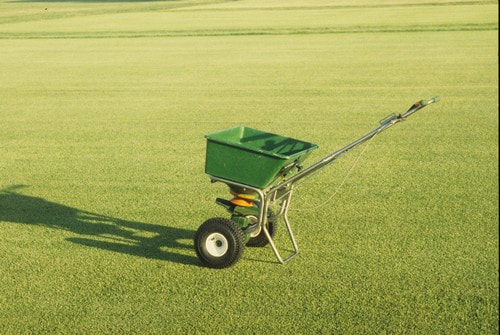
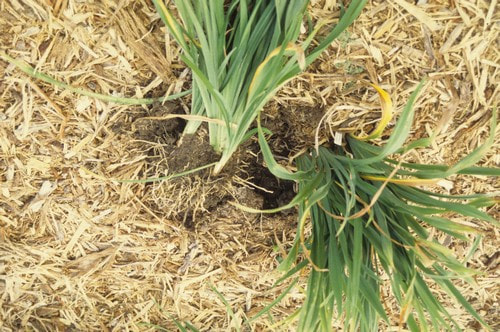
 RSS Feed
RSS Feed
